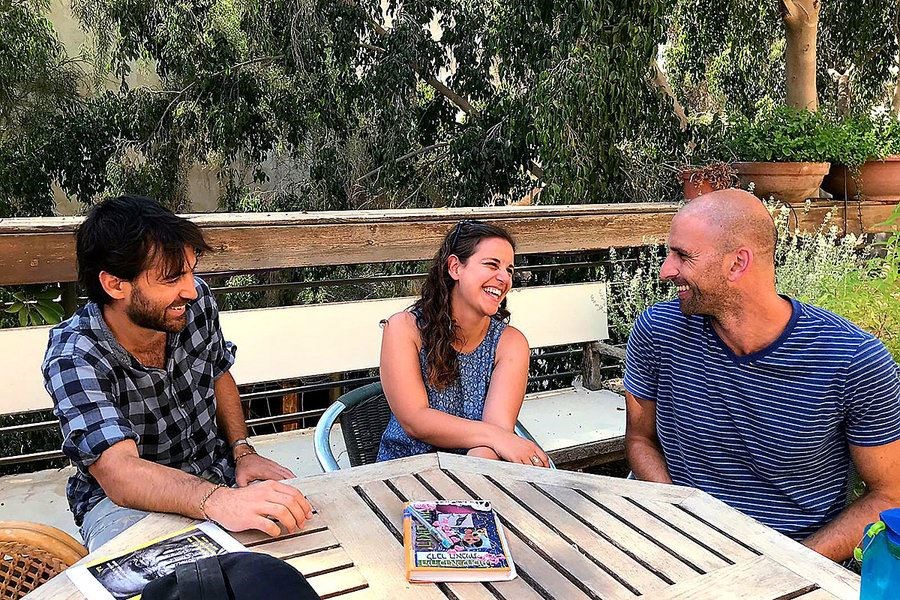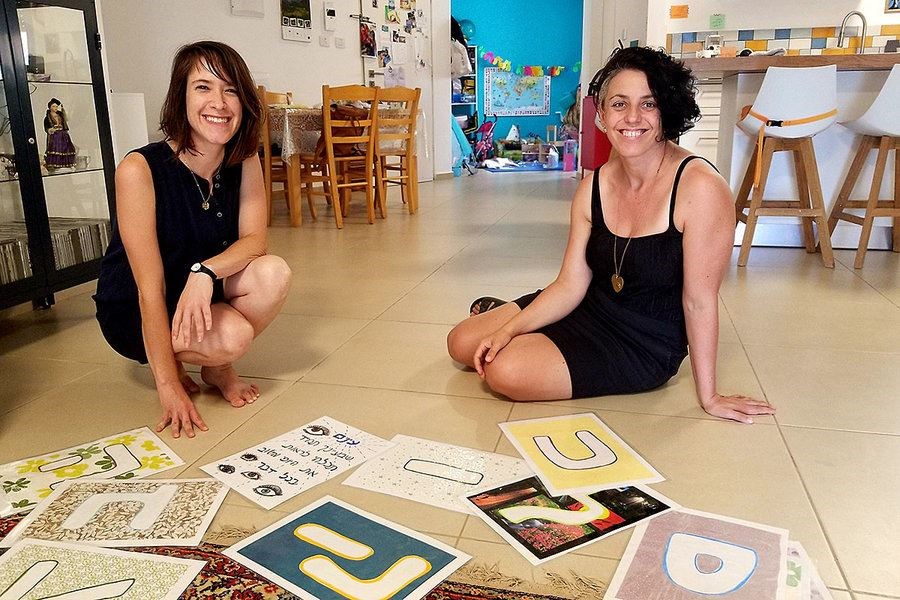Reprinted with permission from The Christian Science Monitor
Old model, new mission: With a modern pioneering zeal and a passion for social justice, young Israelis are reimagining the kibbutz, planting scores of collectives in disadvantaged neighborhoods around the country.
AUGUST 2, 2019 - BEERSHEBA, ISRAEL - The youthful man in cutoff shorts and sandals punches in the security code of a nondescript apartment building in the center of this desert city, bounds up its three flights of stairs, and announces, “This is our kibbutz.”
 Nir Sabo(left), Hyla Kemeny, and Harel Felder, all members of the urban kibbutzim, meet on the roof of an urban kibbutz in Beersheba, Israel. Messrs. Sabo and Felder grew up in Tel Aviv suburbs, while Ms. Kemeny is an immigrant from Canada.Dina KraftIt’s a jarring declaration for anyone familiar with Israel’s iconic kibbutzim – the verdant, mostly agricultural socialist cooperatives that helped pioneer pre-state Israel and define the country’s borders.
Nir Sabo(left), Hyla Kemeny, and Harel Felder, all members of the urban kibbutzim, meet on the roof of an urban kibbutz in Beersheba, Israel. Messrs. Sabo and Felder grew up in Tel Aviv suburbs, while Ms. Kemeny is an immigrant from Canada.Dina KraftIt’s a jarring declaration for anyone familiar with Israel’s iconic kibbutzim – the verdant, mostly agricultural socialist cooperatives that helped pioneer pre-state Israel and define the country’s borders.
Yet in this so-called urban kibbutz, 16 members live here in four apartments, including members with children; another 14 members live in another building nearby, and a smattering live in apartments in the neighborhood. Members share not only living space, but some of their possessions, and pool their incomes.
They also share a modern mission: building a rich communal life for themselves, and doing so in a low-income, underserved urban setting in Israel’s so-called periphery with the goal of improving life for local residents, specifically through education.
“It’s important for me to live a life that is full of meaning and feel like I’m doing something to make a difference, and this is the place where I’m doing that. It’s also important that I take these dreams and try to fulfill them together with friends,” says the cutoff-clad Nir Sabo, who helped found this kibbutz in 2005.
In the past two decades, some 220 urban cooperatives have been established across Israel, some in the form of kibbutzim and communes with shared economies, others in the shape of individuals or families who are economically independent but live in the same apartment buildings or neighborhoods and see themselves as a unit.
While the cooperatives take different forms, they all share a mission as activists committed to improving the education, social welfare, and social justice of the cities and towns where they live. In 2006 an umbrella organization called Eretz-Ir was formed to help support the cooperatives and encourage new ones in the name of promoting social change.
 Ella Orion (left) and Bella Alexandrov, members of the Kama group, an urban collective in Beersheba, sit in Ms. Orion's apartment in the city. On the floor is art utilized in a ceremony that the group created for its children starting grade school.Dina KraftThis growing trend extends beyond Israel’s Jewish majority. There are also cooperatives made up of Arab citizens and Druze, and others with both Jewish and Arab members. There are also cooperatives made up specifically of young Ethiopian Jews.
Ella Orion (left) and Bella Alexandrov, members of the Kama group, an urban collective in Beersheba, sit in Ms. Orion's apartment in the city. On the floor is art utilized in a ceremony that the group created for its children starting grade school.Dina KraftThis growing trend extends beyond Israel’s Jewish majority. There are also cooperatives made up of Arab citizens and Druze, and others with both Jewish and Arab members. There are also cooperatives made up specifically of young Ethiopian Jews.
These cooperative communities are most often located in what are called development towns, far from the economic and cultural heart of central Israel. Considered something of the country’s backwater, these towns are not an obvious draw for educated young people. But those joining these cooperatives in growing numbers say they are choosing to live in these neighborhoods and towns precisely because that is where they can have the most impact on Israeli society.
Gabe Exler emigrated from Chicago nine years ago with his wife and moved directly to Beersheba, where they were founders of a liberal religious community focused on civic engagement that includes immigrants like themselves and native Israelis.
“What I learned is that being here gives people a feeling they are part of something meaningful,” he says. “I think people are also searching for a community they can connect with – to celebrate in times of joy and be comforted with during times of sorrow – and in major urban centers you see loneliness and depression creeping in,” he says.
Mr. Sabo, who grew up in the Tel Aviv suburb of Kiryat Ono, walks across his kibbutz building’s sprawling roof deck, which is lined with potted plants growing herbs and tomatoes – perhaps the only nod to the original kibbutz movement’s origins as an ideology rooted in not just communal, egalitarian living but working the land.
On the deck are scattered picnic tables and chairs where group members like him – graduates of one of Israel’s largest youth movements – gather sometimes late into the night discussing ideas and educational projects they have underway in the city.
These intense, often ideological discussions would be familiar to the country’s original halutzim – the Hebrew word for pioneers – who over a century ago laid the groundwork for creating what became the State of Israel. They were the generation who founded the first kibbutzim – envisioned as utopias of egalitarianism and social justice – and serve as inspiration for Mr. Sabo and his friends as they strive today to foster a more humanist, democratic Israel.
Mr. Sabo’s kibbutz is one of 16 in the Dror Israel movement, the organization for adult graduates of a large socialist-oriented youth movement called HaNoar HaOved VeHaLomed, Hebrew for The Working and Studying Youth, that was founded in 1924. Their work focuses on education in local schools, but also with at-risk youth and vocational training for adults.
“The founders, the halutzim, they are our heroes,” says Gilad Perry, a leader of Dror Israel and himself a member of an educational kibbutz. “But the question of today’s young generation is what does it mean to be a pioneering Zionist today? … It is not draining a swamp, or settling the land. It’s something else. But it is drawn from the same basic idea for being responsible for your life, for your country’s life, and more broadly, for humanity.”
“Today’s kibbutzim are very good places to live in, they have nice swimming pools, nice living standards, this is great,” says Mr. Perry. “But if you are talking about … pioneering today, it is done in the neighborhoods, in the schools, in renewing a sense of what it means to belong to a society, a nation.”
Someone who joins an urban kibbutz, he says, does this “because they feel a strong sense of belonging and attachment – their personal life and life as part of a society are one.”
About 30 miles from Beersheba, near the border with Gaza, is Sderot, the most frequent target in the country for Hamas rockets. Its urban kibbutz is also run by Dror Israel.
Harel Felder, who grew up in Hod Hasharon, outside Tel Aviv, has been a member for nine years. It took time for his parents to understand this was his life, and despite the rocket attacks, and the town’s struggling economy, and living with nine housemates – this was and will continue to be his home.
“I feel like this is where I am working for the future of my friends and the future of my country,” he says.
In a high-rise apartment building in Beersheba lives the “Kama” group, a community that was established 17 years ago. It has evolved from young single people living in various apartments to 15 families with young children living on several floors of the building and in a few homes nearby.
The adults work mostly as educators or social workers. Sabbath dinners are eaten together, there are weekly meetings to discuss issues and update each other on their lives, members created their own ceremonies to welcome children born into the community and celebrate the start of elementary school, and they all contribute to an emergency fund for members who find themselves in need.
Among their civic projects was the establishment of Beersheba’s first cooperative nursery school.
Bella Alexandrov, a trained social worker, describes herself as someone who never planned to live in Beersheba after arriving there from Latvia as an 8-year-old. She still remembers the shock when her family moved into one of its poorer neighborhoods.
“I thought about Israel as a place where bananas and coconuts fell from the trees, and I arrived and saw an ugly neighborhood with drug addicts and trash in the streets and I did all I could to leave,” she says.
But a few years ago she heard about Kama, and after sharing a Friday night Shabbat meal she became intrigued, ended up joining, and eventually took over as director for Eretz-Ir, the urban collectives umbrella. Recently it has been focusing on how to develop employment in periphery areas.
“There is momentum, people are seeking communities, and the state understands the importance of having a strong periphery, so more state money is being allotted to these initiatives,” she says.
For her, being part of Kama is deeply fulfilling. “We talk about leadership, about social change, but being a member gave me a feeling of connection I never had before.”
Page created on 8/5/2019 5:02:09 PM
Last edited 8/5/2019 5:14:58 PM
